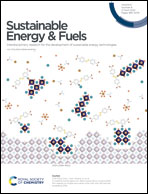Noncovalent interactions induced self-association in anthraquinone-iron aqueous redox flow batteries†
Abstract
Due to safety, potentially low-cost and property tunability, aqueous quinone-based redox flow batteries (RFBs) have drawn considerable attention. Herein, an aqueous anthraquinone-metal RFB with an open circuit voltage of 1.19 V is introduced by employing 3-((9,10-dioxo-9,10-dihydroanthracene-1-yl)amino)-N,N,N-trimethylpropan-1-aminium chloride (1-DPAQCl) and iron(II) chloride with a glycine additive as negative and positive redox-active materials (RAMs), respectively. 1-DPAQCl molecules tend to be bound via noncovalent interactions to form aggregation as the concentration increases. This behavior is confirmed by variable-concentration 1H nuclear magnetic resonance, 2D nuclear Overhauser effect spectroscopy, gel permeation chromatography and 1H diffusion ordered spectroscopy. The calculated solvation free energy agrees with this self-association from the perspective of thermodynamics. The RFB at 0.1 M 1-DPAQCl demonstrates stability up to 600 cycles without observing the erosion of the membrane. At a higher concentration (0.5 M), maximum material utilization (51.8%) of 1-DPAQCl is achieved during 150 cycles at 40 mA cm−2.



 Please wait while we load your content...
Please wait while we load your content...